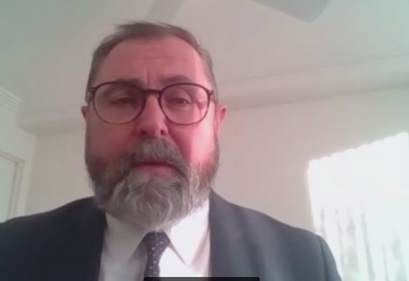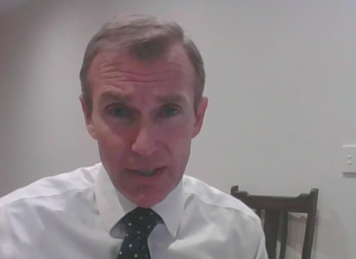The NSW planning minister has indicated he will press ahead with controversial changes to developer levies saying he is “impatient for reform” despite pushback from councils.
Asked if he was open to making amendments to the proposed legislation during a NSW parliamentary committee hearing on Friday, Rob Stokes said he had a vision for reform.
“Yes I do want to move reasonably quickly because I’m impatient for reform,” he said.
But LGNSW president Linda Scott said the plans would result in a “lose, lose, lose scenario”.
Shakeup
The Upper House Inquiry is examining proposed amendments to the Environmental Planning and Assessment Act as part of a wide ranging shakeup of the infrastructure contributions system.
The legislation, which is yet to clear parliament, would implement recommendations contained a Productivity Commission report released last year, but councils say it will also provide the government with unfettered powers to implement other reforms without parliamentary scrutiny.

Among other things, the Bill replaces special infrastructure contributions with a broad-based pooled regional contributions system. It also extends provisions, originally introduced in response to covid, allowing developers to defer payments until after construction.
Councils say the legislation, due to come into force next July, leaves uncertainty about the sorts of projects that will be eligible for contributions, will delay and reduce payments to councils, and allow the planning minister to decide what developer levies are spent on, and when they are paid.
“This is a one-sided approach that risks letting developers off the hook at the expense of communities and still does not resolve the financial needs of councils to support more infrastructure,” Cr Scott told the committee.
This is the risk of a lose, lose, lose scenario. It is not the scenario that the productivity commissioner put forward.
Linda Scott
“This is the risk of a lose, lose, lose scenario. It is not the scenario that the productivity commissioner put forward.”
Councils ‘sitting on unspent funds’
City of Sydney Lord Mayor Clover Moore said the legislation would allow the state to pocket 50 per cent of the City’s developer contributions and expect Council to make up the shortfall by raising rates.
“We estimate that the city would need to raise rates by 13 per cent a year,” she said.
She said the legislation would radically change the way local infrastructure is planned, funded and delivered and curtail the ability of local government to deliver.
“This bill threatens the financial viability of local councils,” she said.

Marcus Ray, deputy secretary of planning and assessment at DPIE, said councils couldn’t complain while they were sitting on $3.7 billion of unspent contributions.
The amount of contributions coming into the system is increasing but councils aren’t increasing their spending rates.
Marcus Ray
“The amount of contributions coming into the system is increasing but councils aren’t increasing their spending rates,” he said.
The government’s reform package would enable those funds to be spent more quickly and effectively, he said.
Modeling also showed that in 20 years council funding from rates would be 6.9 per cent more than they are now, Mr Ray added, and the legislation gave them more options for borrowing money.
Concern about regional infrastructure contributions
The new system of Regional Infrastructure Contributions would pool contributions into separate funds for Greater Sydney, Central Coast, Hunter and Illawarra/Shoalhaven.
Riverina Joint Organisation Chairman Rick Firman said regional councils were concerned that the new structure meant the money could be used for infrastructure outside the region and even the state.
“This means a contribution can be collected in Temora Shire but invested in Byron Bay, or even apparently outside NSW.
“Communities expecyt that development contributions from developments in their respective areas will be spent in their LGA.”
Cr Moore also said infrastructure contributions should be spent locally.
The bill takes funding from the areas of greatest infrastructure need and puts it into a pot that can be dispersed anywhere with no accountability on where or what it is sent on.
Sydney Lord Mayor Clover Moore
“The bill takes funding from the areas of greatest infrastructure need and puts it into a pot that can be dispersed anywhere with no accountability on where or what it is spent on.”
She said the $13 billion of private investment for the Green Square redevelopment, a state initiative, wasunderpinned by $1.3 billion of local infrastructure and community facilities funded by the city and developers.
Seventy-five per cent of council’s contribution came from developer contributions and 25 per cent from the rate base.
Productivity Commissioner Peter Acchtersraat said the system would allow infrastructure to be pooled for major porjcts.
“It may well be that they decide that not every local council area needs a big hospital, so there’s going to be on hospital for that whole region,” he said.
Fears of rate pegging trade off
Councils are also concerned about what they say are plans to tie rate peg reforms to infrastructure contributions.
I am very happy to guarantee that over the long term no council will be worse off.
Planning minister Rob Stokes
The productivity commission has recommended that rates should be tied to population growth to strengthen the financial sustainability of local government, a move LGNSW has welcomed.

But Cr Scott says the proposed levy changes should under no circumstances viewed as a trade off for uncapping the rate peg, which would amount to cost-shifting from developers to rate payers.
Mr Stokes denied any connection between rate pegs and infrastructure reform.
He said instead of worrying about losing money under the reforms councils, should be worrying about spending their unspent funds.
He said he could categorically guarantee councils wouldn’t be worse off under the legislation.
“I am very happy to guarantee that over the long term no council will be worse off,” he said.
“In fact they’ll be considerably better off.”





If the Planning Minister Rob Stokes is very happy to gaurantee that over the long term no council will be worse off and in fact they will considerably better off I am sure he will be very happy to enter into a legal agreement with each municipality to that effect
Just like those voluntary council amalgamations have seen 30% harmonisation rate increases and 15% more staff and associated costs … definitely needs to be car park rort proofed!
This seems to reflect the open slathery approach of NSW (and Federal) governments to push development in any form or shape – all concrete and no responsibility eg for the destruction of the natural environment, overcrowding, heat sinking, pollution, rotten workmanship etc. AND Councils will lose out of the already inadequate amount of money developers pay towards infrastructure ..including parks and roads. So they’ll have to increase rates a LOT.
Ask Mr. Stokes about the fast tracking of a Walker Corp. Macquariedale Road planning proposal, knocked back twice by local Council for many reasons. Enter Mr Lang Walker yet again & his election to the Urban Taskforce executive committee & then ministeral meetings. The land in question was recommended by the chief scientist report to be protected & enhanced as Koala corridor, it is Koala habitat a critically endangered Cumberland plains woodlands.
One only had to look at the first developer contribution that was/is Ultimo/Pyrmont @ 3 percent under Better Cities guarantee to be spent on local community infrastructure.
The State collected the levy the City Council to over see the books.
That quickly changed once the State took total control of funds refusing to provide data to the City hence 30+ yrs.down the track the the accounting is total shambles as the break down of cash collected and infrastructure provided in exchange for contributions.
Both State and Council under changing Governance have disregarded under taking guarantee’s social contracts as being in the past. None have been for filled. Empty guarantee is worthless per history of Ultimo/ Pyrmont Better Cities undertakings by all involved.